NCERT Solutions for English Class 6 Chapter 5 - FREE PDF Download
Vedantu offers NCERT Solutions for Class 6 English, from the Unit “Culture and Tradition” and offers detailed solutions to all textbook questions, crafted by expert teachers and subject matter specialists. This unit, Culture and Tradition features the following chapters:
Hamara Bharat—Incredible India!
The Kites
Ila Sachani in Embroidering Dreams with her Feet
National War Memorial
These chapters highlight the values of Culture and Tradition in the country and showcase it in a beautiful manner. Download the FREE PDF for NCERT Solutions for Class 6 English Chapter 5 and boost your exam preparation with confidence!
Glance on Class 6 English (Poorvi) Chapter 5 - Culture and Tradition:
1. Hamara Bharat—Incredible India!
The chapter introduces the “Ek Bharat, Shreshtha Bharat” program, aimed at celebrating India’s unity in diversity.
Students discuss how the program helps in fostering national integration despite varied cultural backgrounds.
The teacher and students engage in a conversation about the significance of the program and its impact on promoting national unity.
Renu highlights the essence of India’s diverse cultural heritage while emphasising the importance of unity.
2. The Kites
The story portrays kites as symbols of determination and courage.
It describes the kites’ journey and struggles against the wind, reflecting their resilience and strength.
Throughout the story, the chapter emphasises the qualities of perseverance and bravery.
The kites’ adventures symbolise the spirit of overcoming challenges and achieving goals.
3. Ila Sachani: Embroidering Dreams with Her Feet
The chapter features Ila Sachani, a skilled embroiderer who creates intricate designs using her feet.
It highlights her remarkable talent and dedication to her craft despite physical challenges.
The story showcases the importance of passion, skill, and determination in pursuing one’s dreams.
Ila Sachani’s journey serves as an inspiration for overcoming obstacles and achieving success.
4. National War Memorial
The chapter focuses on the National War Memorial, a tribute to the soldiers who sacrificed their lives for the nation.
It explains the significance of the memorial in honouring and remembering national heroes.
The narrative emphasises the values of patriotism, respect, and gratitude towards those who served the country.
The chapter provides insights into the role of memorials in preserving national history and heritage.
Access NCERT Solutions for Class 6 English Chapter 5
Hamara Bharat — Incredible India!
1. What has Bharat always been known for?
Ans. Bharat has always been known for its rich and diverse cultural heritage, including its traditions, festivals, and languages. The country's unity in diversity is celebrated and strengthened through initiatives like the “Ek Bharat, Shreshtha Bharat” program.
2. What is attractive about Bharat?
Ans. Bharat is attractive due to its vibrant cultural heritage, diverse traditions, and historical landmarks. Its unique blend of ancient customs, festivals, and modern advancements creates a captivating and colorful tapestry that draws interest and admiration.
3. What is special about the fact that the people live here in unison?
Ans. The special aspect of people living in unison in Bharat is the harmony and unity that exists despite its vast cultural, linguistic, and regional diversity. This collective spirit fosters a sense of national identity and togetherness, celebrating differences while working towards common goals.
2. What geographical features does the passage mention?
Ans. Mountains – Including the Himalayas in the north.
Rivers – Such as the Ganges, Yamuna, and Brahmaputra.
Deserts – Like the Thar Desert in the west.
Coasts – Both the western and eastern coasts, including the Arabian Sea and the Bay of Bengal.
These features contribute to Bharat’s diverse landscapes and natural beauty.
5. What is the advice given to everyone?
Ans. The advice given to everyone is to embrace and celebrate the unity in diversity that Bharat represents. It encourages people to appreciate and respect the various cultures, traditions, and regional differences while fostering a sense of national unity and togetherness.
Let us do these activities before we read.(Pg 132)
Our country is beautiful and every state has its own uniqueness. The words given below are part of our identity. Complete these words with the correct vowels (A, E, I, O, U).
(a) We like to decorate our homes with our f __ l k __ r t.
Ans. Folkart
(b) Our c __ l t __ r e consists of our ideas, customs, traditions, values, arts, and languages.
Ans. Culture
(c) All of us celebrate our f __ s t __ v __ l s together.
Ans. Festivals
(d) We tell stories to our children to teach them about our c __ l t __ r e, h __ s t __ r y, and l __ g __ n d s
Ans. Culture, History, Legends
(e) We have our own l __ n g __ a g __ s to talk to each other.
Ans. Languages
Let Us Discuss (Pg 133)
1. What is the Ek Bharat, Shreshtha Bharat programme all about?
Ans. The "Ek Bharat, Shreshtha Bharat" program is aimed at celebrating and enhancing national unity by promoting mutual understanding and cultural exchange between different states and regions of India. It focuses on recognizing and appreciating the diverse cultural heritage of India while fostering a sense of national pride and togethernes
2. Why is this programme being conducted?
Ans. This program is conducted to strengthen national integration by fostering a deeper understanding and appreciation of India’s diverse cultures. It aims to promote unity among different states and regions, celebrating their unique traditions while emphasizing the common identity of being Indian.
Let us discuss (Pg 136)
On the basis of what the speakers said about the art forms, complete the table given below.
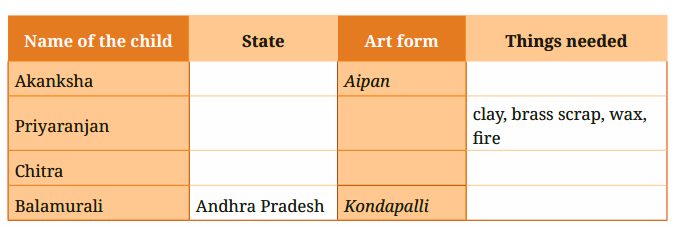
Ans:
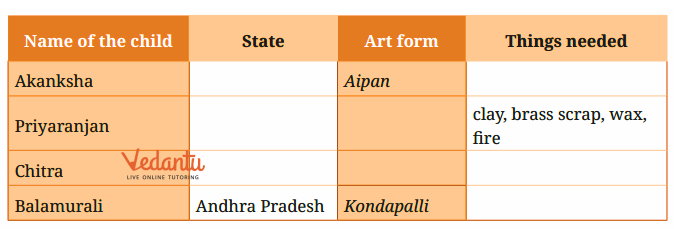
Let us think and reflect (Pg 136)
1. Fill in the blanks to complete the following sentences.
(a) The designs for Aipan are taken from ________________ and
________________.
Ans: Nature and Everyday Life
(b) Dhokra metal craft is very old because it is ________________ old.
Ans: Very
(c) A base is needed for coconut shell craft to make it ________________.
Ans: Smooth
(d) Soft wood, ________________ and colours are used to make Kondapalli
toys
Ans: Sawdust, Tamarind Paste
2. Why does Akanksha’s family make Aipan?
Ans: Akanksha’s family makes Aipan because it is a traditional art form that holds cultural significance and is used for various ceremonial and decorative purposes. The intricate designs often reflect aspects of nature and daily life, embodying the family’s heritage and artistic expression.
3. In Dhokra, why does wax come out of the small openings?
Ans: In Dhokra metal craft, wax comes out of the small openings because the craft uses the lost-wax casting method. During the casting process, molten metal is poured into the mold created around a wax model. As the metal solidifies, the wax melts and escapes through the small openings, leaving behind the intricate metal design.
4. What is common in the toys made in Balamurali’s village and coconut shell craft in Kerala?
Ans. What is common between the toys made in Balamurali’s village and the coconut shell craft in Kerala is their reliance on traditional craftsmanship and locally sourced materials. Both crafts showcase intricate artistry and reflect the rich cultural heritage of their regions.
Let us learn (Pg 137)
1. Priyaranjan, Chitra and Balamurali share how art works of their states are made. They use some words to show the order of making it. Those words are given in the box below

(i) ____________ I get up and go to take a shower. (ii) ____________, I wear my school dress. (iii) ____________, I eat my food. (iv) ____________, I wear my shoes. (v) ____________, I pick up my bag and go out of my home
Ans.
(i) first
(ii) Next
(iii) After That
(iv)Then
(v) Finally
2. The children from different states each speak about one art form from their state. When they speak, they use the first form of the verb. It shows something that happens regularly. It is called the present tense. With he, she and it, -s/-es is used with the verb to show the present tense. Make five sentences with the help of the words given in the table below. Use -s/-es wherever necessary. Two examples are given.
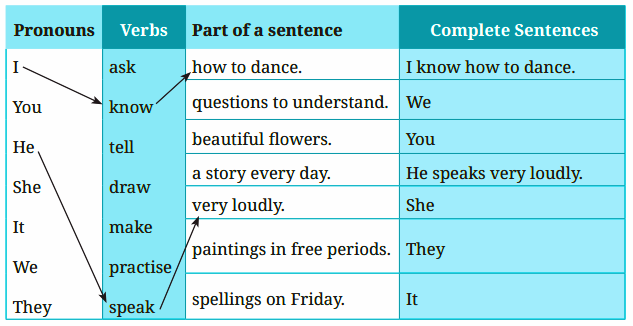
Ans:
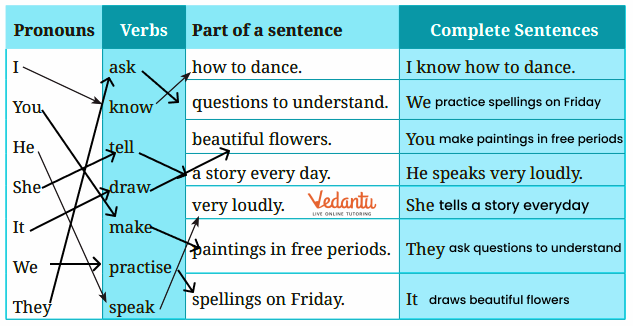
Let us listen (Pg 138)
(a) Name of the speaker : __________________________
Ans. Sushil
(b) The town of the speaker
Ans. Jabalpur
(c) The state he belongs to :
Ans. Madhya Pradesh
(d) The name of the food item
Ans. Gakkad Bharta
(e) Vegetables roasted for bharta
Ans. Brinjal & Tomatoes
2. Now, listen to the description again and complete the flowchart on how to make gakkad bharta.

Ans.

Let us Write (Pg 139)
You heard children from different states speak about the art forms from their state. Discuss in pairs which art form you liked the most. Now, write a paragraph with five sentences giving your reasons for liking it
Ans: I liked the art of Dhokra metal craft the most. The ancient technique of lost-wax casting used in Dhokra creates intricate designs, making each piece unique and beautiful. The craftsmanship involved requires a lot of skill and patience, which I greatly admire. Moreover, the use of natural materials and traditional methods makes the art eco-friendly and sustainable. Dhokra artifacts also carry a rich cultural history, making them both artistic and meaningful. These reasons make Dhokra metal craft stand out for me among other art forms.
Let us explore (Pg 139)
1. Madhubani painting is a traditional art form from Bihar. The artists use
natural colours to make them on the walls of their houses. You can also
make and use natural colours as given below.
• yellow from haldi
• green from leaves
• red from red flowers/geru/sindoor
• orange from flowers
• blue from neel/indigo powder
Given below is a Madhubani painting. Colour it with natural colours or any other colour
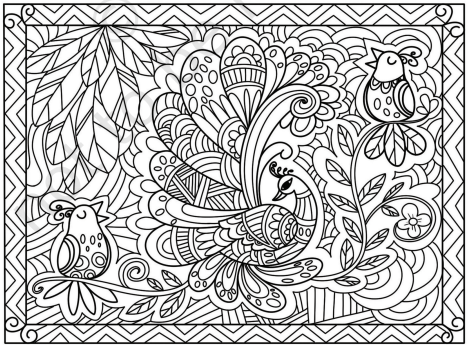
Ans. Do it yourself
The Kites:
Let us do these activities before we read (Pg 141)
1. Answer the following questions and share them with your teacher and classmates.
(a) Have you ever flown a kite or seen someone fly it? Where? When?
(b) Describe the kite—colour(s), shape, design of tail, any other detail.
(c) What did you think when you saw the kite up in the sky?
Ans. (a) I have flown a kite in my native town of Trichy, Tamil Nadu when i was 11 years old.
(b) The kite was diamond shape, red and yellow colours and the tail extruded from the bottom, waving in the wind as the kite took flight.
(c) I felt happy and thought about all the memories in my native, when I saw the kite up in the sky.
2. Search the internet for videos on Kite Festivals and watch them with your teacher and classmates.
(a) Share the things with your teacher that you saw and what the people were doing.
Ans. During the kite festival, I observed a variety of kites with vibrant colors and unique shapes. People were enthusiastically flying kites of different designs, including traditional diamond-shaped kites and innovative, intricate shapes like dragons and butterflies. There were also kite-flying competitions where participants showcased their skills by performing aerial tricks and maneuvers. The festival was filled with excitement, with families and friends gathering together, cheering each other on, and enjoying the lively atmosphere.
(b) Would you like to participate in this kind of festival? Why?
Ans. Yes, I would love to participate in a kite festival because it seems like a lot of fun and a great way to enjoy a community event. It would be exciting to see and fly different types of kites, and the festive atmosphere would make it a memorable experience. Additionally, participating in such an event would give me a chance to learn new skills related to kite flying and meet new people who share similar interests.
(c) What kind of kite would you like to fly?
Ans. I would like to fly a kite with a colorful and intricate design, perhaps one shaped like a dragon or a mythical creature. I think a kite with bright colors and interesting patterns would be visually striking and fun to fly. Additionally, I would choose a kite that is capable of performing some basic tricks in the air, as it would add an extra element of excitement to the experience.
3. Look at the picture and complete the sentences. Share your responses with your teacher

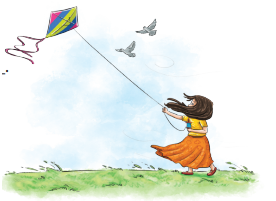
(a) I can see ___________, ___________ and ___________ in the picture.
(b) The weather in the picture is ___________.
(c) The kite is ___________ high in the sky.
(d) The child is ___________ from below.
(e) The tail of the kite ___________.
Ans.
A girl, kites and birds
Windy
Flying
Looking
Is waving around
4. Now, think and answer.
(a) List two more things that you want to add to the picture.
(b) If I were the child, I would ___________.
(c) If I were the kite, I would ___________.
Ans.
Clouds, Trees
Want to fly like the kite
Want to fly higher
Let us Discuss (Pg 143)
1. Read the poem silently. As you read, mark the given statements as True or False.
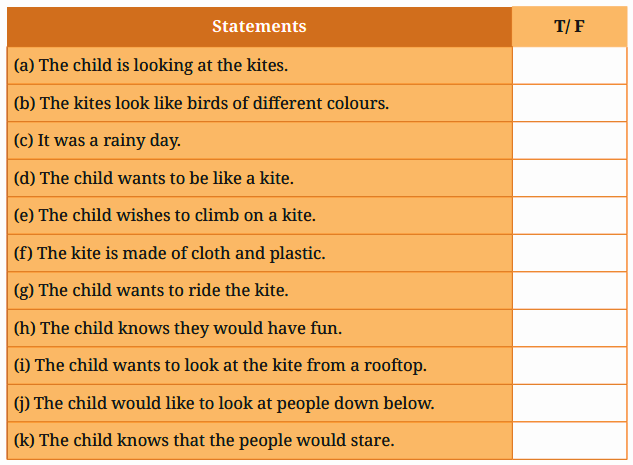
Ans.
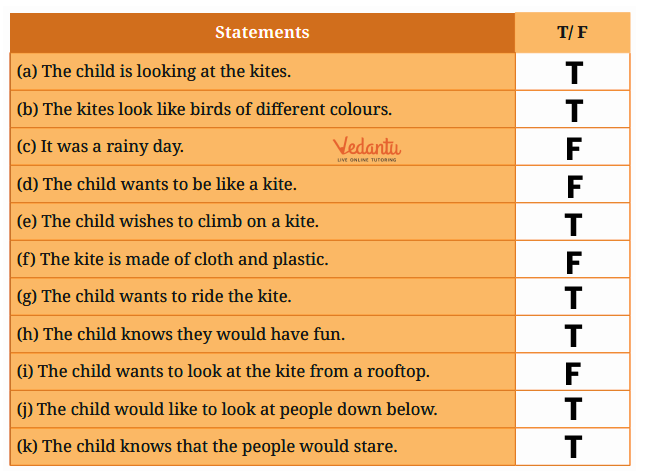
2. Complete the following sentences
(a) The poet says that the kites are like coloured birds –
See the kites fly/Like coloured birds in the sky.
The kites have been compared to b __ __ __ __ because they ______________.
Ans: birds, fky high in the sky
(b) The child wishes to be like air – I wish I were small / And as light as air.
The child wishes to be as l __ __ __ t as __ __ __. The child wishes to be able to c __ __ m __ on a kite and fly.
Ans: light, air, climb
3. Find a set of words from the poem that begin with the same consonant sound.
Stanza 1
Which consonant sound do both words begin with?
Stanza 3
Which consonant sound do both words begin with?
This is called alliteration. For example, big bright blue bag, funny fan,
etc.
Create 4 other sets of words using alliteration
Ans:
Finding Alliteration in the Poem:
Stanza 1:
Words: “Kites” and “coloured”
Consonant Sound: /k/ (though not a perfect match, this is close)
Stanza 3:
Words: “Paper” and “wings”
Consonant Sound: /w/
Other Examples of Alliteration:
Sunny sky – /s/
Brilliant blue – /b/
Fluttering flags – /f/
Happy hearts – /h/
Alliteration involves the repetition of the same consonant sound at the beginning of closely connected words.
4. In the last stanza, the two words that the poet repeats are __________, __________ to tell us that the kite is flying __ __ __ y high.
Ans. In the last stanza, the two words that the poet repeats are "high" and "air" to tell us that the kite is flying high in the air.
5. Study each stanza and underline the rhyming words from the end of each line. Also, circle the end words in the stanzas that do not rhyme.
Ans. Do it yourself
Let us think and reflect
1. Read the given lines from the poem and answer the following questions.
What fun it would be
To look right down,
Over the park
And the rooftops of town
(a) Circle the word that does not share the same feeling as ‘fun’: joy, excitement, care, happiness.
Ans. Care
(b) Which line tells us that the poet was somewhere above?
Ans. The line that indicates the poet was somewhere above is:
"What fun it would be / To look right down,"
This suggests that the poet is imagining the experience of looking down from a higher position.
(c)Choose the scene the child saw.
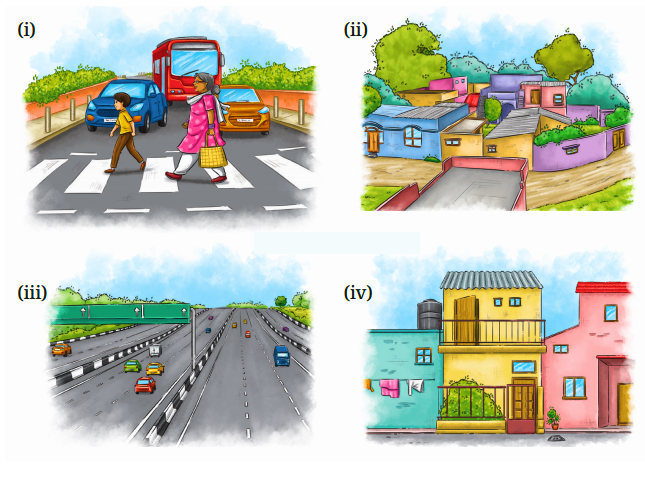
Ans:

2. Answer the following questions.
(a) How does the poet describe the kites in the first two lines?
Ans. The poet describes the kites as "coloured birds" flying in the "wind-whipped sky." This comparison highlights the kites' vibrant colors and the dynamic, lively movement in the sky.
(b) Why does the child say that they have to climb a tree first to get onto the kite?
Ans. The poet describes the kites as "coloured birds" flying in the "wind-whipped sky." This comparison highlights the kites' vibrant colors and the dynamic, lively movement in the sky.
(c) What are the songs that the child hears when flying atop the kite?
Ans. The child hears the "songs that the wild wind sings" when flying atop the kite. This suggests that the sounds of the wind as it rushes past the kite create a musical, enchanting experience.
(d) Why did the people look up at the child and stare? If you looked up and saw that, what feelings would you have?
Ans. The people looked up and stared because they were amazed by the sight of the child flying high in the sky on the kite. If I looked up and saw that, I would feel a mix of awe, wonder, and admiration for the incredible and magical scene.
(e) If you were the kite carrying the child high up in the air, what would you tell them?
Ans. If I were the kite carrying the child, I would tell them: “Enjoy the freedom and beauty of the sky. Look down and see the world from a new perspective. Let the wind carry you on this wonderful adventure and savor every moment of this magical flight.”
Let us learn
Now, complete the given conversation by filling the blanks with some ‘parts of a kite’ words from above.
Bina : I love the long yellow t _ _ _ at the end of my kite.
Ans: Tail
What colour is your kite?
Saroj : My kite’s c _ _ _ _ is pink. The s _ _ _ _ e is black.
Ans: Colour. Spine
Bina : Oh wonderful! My kite l _ _ _ is red. The r_ _ l that wraps it is green. I really like it.
Ans: Line, reel
Saroj : My kite line is red too. The tip of my kite has a blue _ _ _ e.
Ans: Line
Bina : Beautiful! Let’s go and fly our pretty kite.
2. Let us create a poem using words in a kite!
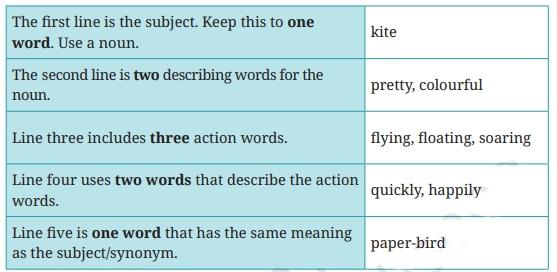
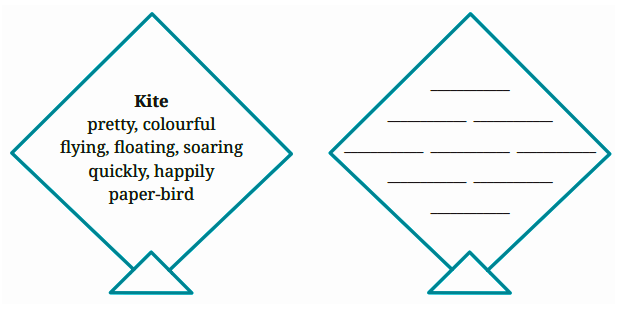
3. The poet uses the word ‘fly’ and ‘drift’ to tell us about the kite’s movement.
(a) Circle the words that match with the ‘drift’ movement. You can choose more than one word.
slow, fast, quick, upward, downward, round and round, float
Ans: Slow, upward downward, round and round
Let us listen
Listen about the Kite Festival in India. As you listen, circle the words that are not correct. Then, listen again and write the correct words.
Hello everyone! I’m happy to share with you some details about the Kite Festival. It is a popular festival in India and it takes place during Makar Sankranti in January. People can even be seen flying kites from their terraces and rooftops and taking part in kite flying competitions. This festival is celebrated as Uttarayan in Western India. The festival gives everyone a chance to look at kites of different shapes, sizes, and colours. Gujarat is the main centre of celebrations but Uttarayan is also celebrated in Rajasthan and Telangana. In Karnataka, the Tourism Department has also been organizing the kite festival once each year. Punjab also celebrates this festival of kites during Baisakhi and Basant Panchami. Kite fling is a tradition that is deep-rooted in Indian culture and the Kite Festival is eagerly awaited. This is also a reason why people across India also fly kites to celebrate Independence Day. Happy kite-fling to all of you!
(a) Kite Festival is celebrated during the month of June.
(b) The International Kite Festival is named Uttarayan in Eastern India.
(c) Uttarayan is mainly celebrated in Gujarat, but also in Maharashtra and Telangana.
(d) During the Kite Festival, we can see kites of different shapes, sizes and colours.
(e)In Karnataka, the Tourism Department organises the kite festival every year.
(f) The Punjab region celebrates Basant Panchami and Baisakhi by flying kites.
(g) People of India also enjoy flying kites on Earth Day.
Ans.
Kite Festival is celebrated during January.
The International Kite Festival is named Uttarayan in Western India.
Uttarayan is mainly celebrated in Gujarat, but also in Rajasthan and Telangana.
Correct
Correct
Correct
People of India also enjoy flying kites to celebrate Independence Day.
Let Us Write (Pg 146)
1. Imagine yourself as a kite. In pairs, first discuss all the following hints.
What shape of kite are you? What colours do you have? What other parts of yourself are you happy about? • Where are you? Who do you belong to? What activities do you do? Who are your friends? • Do you have any message for humans?
Ans: Shape and Colors: I am a diamond-shaped kite, vibrant and eye-catching. My primary color is a bright, sunny yellow with red and blue accents along the edges.
Other Parts: I’m proud of my long, flowing tail which dances gracefully in the wind. It’s adorned with colorful streamers that add to my charm and help me stay balanced.
Location: I’m soaring high in the clear, blue sky over a lush, green field. It’s a perfect day with a gentle breeze, ideal for flying.
Owner and Activities: I belong to a child who loves spending time outdoors. We often go to the park together, where I’m flown during picnics and on special occasions. My owner enjoys watching me flutter and glide, and we make wonderful memories together.
Friends: I have other kites as friends—some are big and some are small, with various shapes and colors. We often meet in the sky, playing together and creating a beautiful spectacle for those on the ground.
Message for Humans: My message is to cherish the simple joys in life. Just like flying a kite brings happiness and freedom, take time to appreciate the small moments that make life special. Enjoy the outdoors, connect with nature, and let your spirit soar.
2. Now, write a paragraph of about 100 words, with the title - I am a Kite
Ans. I am a vibrant, diamond-shaped kite, adorned in bright yellow with striking red and blue accents. My long, colorful tail sways gracefully in the wind, adding to my beauty and balance. Soaring high above a lush, green field on a sunny day, I am owned by a child who delights in our outdoor adventures. Together, we create joyful memories in the park, where I dance in the sky among friends of various shapes and hues. My message to humanity is simple: embrace the small joys and freedom of life, let your spirit soar, and savor the beauty around you.
Ila Sachani: Embroidering Dreams with her Feet
Let us do these activities before we read. (Pg 151)
1. Look at the given picture and information. Discuss the questions with your teacher and classmates.

(a) Do you think Pranav’s task is simple? Why or why not?
Ans. Pranava’s task to make it big as an artist, singer as well as sportsperson without both hands is an extremely difficult and unparalleled achievement which is extremely distinguishable and unmatchable.
(b) How does Pranav’s special ability make you feel?
Ans. Pranav’s special ability to make it in his chosen fields even without hands makes me feel extremely proud of him while also awe-inspired due to his extremely difficult feat.
(c) What qualities do you think were important for Pranav to become successful?
Ans. The key qualities crucial for Pranav's success include:
Willpower: A firm resolve to tackle challenges and push through difficulties.
Creativity: Developing inventive methods for tasks usually performed by hand.
Determination: A steadfast commitment to achieving goals.
Patience: The ability to persistently practice and improve skills over time.
Optimism: Keeping a positive attitude even when facing obstacles.
(d) What message does Pranav’s story give us?
Ans. Pranav’s story conveys a strong message that physical limitations do not determine one’s abilities or potential. It highlights the significance of resilience, creativity, and a positive mindset in facing obstacles. His journey serves as an inspiration for others to chase their dreams and remain undeterred by challenge
2. Look at the picture of Kathiawar embroidery. Discuss in pairs.
(a) List the steps you think are needed to create this embroidery.
Ans. Drawing the design on the fabric.
Selecting suitable threads and colors.
Tautly stretching and securing the fabric in a frame or hoop.
Applying different embroidery methods to craft the design.
Securing loose threads and making final adjustments.
Washing and ironing the completed work.
(b) Discuss if these steps can be done with feet, instead of hands.
Ans: Although extremely difficult, these steps can be done with feet instead of hands. It would however, require extreme levels of patience, practice and hardwork.
(c) What efforts would be needed if someone has to embroider with their feet? Do you think it is possible?
Ans: Embroidering with feet would require considerable effort and adaptation. Here are the key challenges and efforts involved:
Specialized Equipment: A custom setup or frame would be needed to hold the fabric and keep it steady. This could involve adjustable supports and foot-controlled mechanisms.
Foot Training: Developing precise control and dexterity with the feet would be essential. This would require significant practice and coordination to handle the needle and threads effectively.
Adapted Techniques: Traditional embroidery techniques would need to be modified. Techniques that typically require fine motor skills with hands would need to be adjusted for foot use.
Strength and Endurance: Embroidering with feet would demand strong and agile feet muscles, as well as endurance for prolonged periods of work.
Assistive Tools: Custom tools or adaptations might be necessary, such as foot pedals for guiding the needle or stabilizing the fabric.
Let us discuss (Pg 155)
Read the paragraphs and write the main idea for each. Then, match the main idea with two supporting details.

Ans:
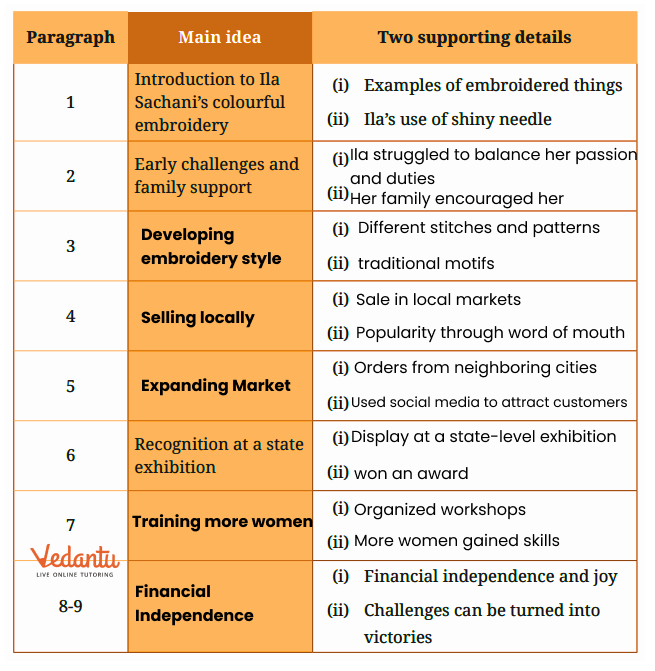
Let us think and reflect (Page 156)
1. Read the following lines and answer the questions that follow.
Unlike other children, she could not use her hands in the usual way. While other small hands drew figures in the sand or plucked wild flowers, she wondered why she could not join them. She too wanted to hold a chalk in her hands and draw figures on a slate.
(a) Choose the correct option to fill in the blank.
‘Unlike other children’ means that Ila was _____________. (unaware/
different/simple)
(b) What could Ila have felt when she could not join others in things they did?
(c) Complete the following with a suitable reason.
Ila could not draw figures on the slate because ___________.
Ans. a) different
(b) Ila likely felt frustration and sadness at not being able to join others in activities they enjoyed. She may have experienced a strong desire to participate and a sense of isolation or inadequacy due to her physical limitations.
(c) Ila could not draw figures on the slate because she was born with her hands hanging loosely by her sides, making it difficult for her to use them in the usual way.
2. What creative ways did Ila and her family use to overcome the challenges she faced?
Ans. They instructed her on how to create many beautiful patterns using her feet, overcoming her physical challenges.
3. How did ‘new independence’ help Ila?
Ans. The 'new independence' helped Ila by enabling her to perform tasks and express her creativity using her feet. It allowed her to overcome physical limitations, gain confidence, and achieve skillfulness in embroidery, which provided her with a sense of accomplishment and self-reliance.
4. Why was the first state exhibition an important event in Ila’s life?
Ans. The first state exhibition was an important event in Ila’s life because it provided her with an opportunity to showcase her unique embroidery skills and gain recognition for her talent. It was a significant milestone that demonstrated her achievements despite her physical challenges and validated her hard work and dedication.
5. What does the sentence, ‘art has the power to rise above physical boundaries and touch the soul’, tell us about the power of art?
Ans. The sentence, "art has the power to rise above physical boundaries and touch the soul," conveys that art transcends physical limitations and has a profound emotional and spiritual impact. It suggests that art can connect deeply with individuals on a personal level, offering inspiration, healing, and a sense of connection beyond physical constraints.
6. How can we be helpful and encouraging like Ila’s family and friends when someone faces challenges
Ans. To be supportive like Ila’s family and friends, we can offer practical help, listen empathetically, encourage perseverance, share resources, and respect their unique challenges.
7. How can Ila’s story help others to overcome challenges in their lives?
Ans. Ila’s story can inspire others by showing that determination, creativity, and support can help overcome significant challenges. Her success despite physical limitations encourages people to persist and find innovative solutions in their own lives.
Let Us Learn
1. Read the words from the text given in Column A. Then, try to understand what they mean by reading the sentences in Column B. Now, match the word to its correct synonym in Column C. There are two extra synonyms given. You may refer to the dictionary.
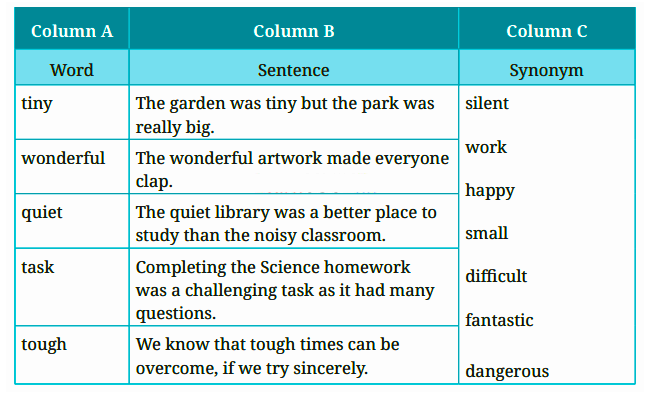
Ans.
Tiny - small
Wonderful - fantastic
Quiet - silent
Task - work
Tough - difficult
2. Unscramble the antonyms of the words in Column A. An example has been given for you.
Example: display – E D I H (H I D E )
(a) tiny – E G H U (H __ __ __)
(b) wonderful – R E E B L I T R (T __ R __ __ B ___ E)
(c) quiet – I Y N S O (N __ __ __ __)
(d) task – S I A E M T P (P __ S T __ __ E)
(e) tough – SEYA (E __ __ __)
Use these antonyms in sentences of your own.
Ans: (b) TERRIBLE
(c) NOISY
(d) PASTTIME
(e) EASY
3. Read the sentences from the text and focus on the highlighted words.
• You will see lots of bright colours.
• There are many lovely things like cushions and bedcovers.
• They taught her to create many beautiful patterns using her feet!
• She learned many styles.
• She received many awards
(a) The highlighted words tell us about the quantity. Choose what the words show.
(i) Unmentioned quantity
(ii) Large quantity
Ans. Large Quantity (ii)
(b) Let us now understand what words of quantity tell us.
Fill in the blanks to complete an example for each word of quantity. Hints are given in the brackets.
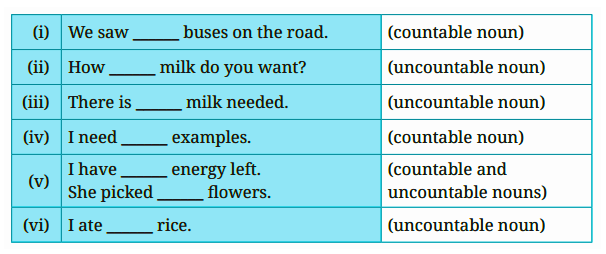
Ans.
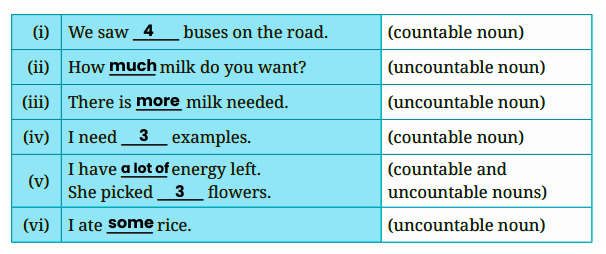
Let us listen (Pg 158)
You will listen to a talk about Kathiawar embroidery. As you listen, circle the correct option.
a. Form
(i) old
(ii) new
Ans. old (i)
b. Colours
(i) soft
(ii) bright
Ans. bright (ii)
c. Stitches
(i) running stitch
(ii) chain stitch
Ans. Chain stitch
e. Things used
(i) small mirrors
(ii) shapes of buttons
Ans. small mirrors
(f) Designs
(i) Elephants and horses
(ii) squares and triangles
Ans. squares and triangles
In pairs, write down two questions you would like to ask Ila Sachani.
(a) Look at two examples.
Where were you born? Did you go to school? The Yes/No questions use a rising tone at the end.
Ans.
The questions I would love to ask Ila Sachani are:
How did you start learning to use your feet for your embroidery?
What did you do when you felt like giving up?
(b) Speak the example questions aloud as a peer activity at least five times.
Ans. Do it yourself
(c) Now, take turns to ask your questions to another classmate. Speak clearly and with the correct rising tone as shown in (a).
Ans. Do it yourself
Benefits of NCERT Solutions for Class 6 English Chapter 5
NCERT Solutions for Class 6 English Chapter 5 from the Poorvi textbook provides detailed explanations of the chapter, helping students grasp the key concepts and themes.
By reading and understanding the solutions, students can enhance their vocabulary and language skills, which are crucial for mastering English.
These solutions are an excellent revision tool, allowing students to quickly review important points before exams.
With accurate answers and explanations, students can gain confidence in their ability to tackle exam questions related to the chapter.
NCERT Solutions for Class 6 English Chapter 5 provides reliable support for completing homework assignments, ensuring that students can submit accurate and well-structured answers.
Important Study Material for English Chapter 5 Class 6 - Culture and Tradition
S. No | Important Study Material Links for Chapter 1 |
1. | Class 6 English Culture and Tradition Important Questions |
2. | Class 6 English Culture and Tradition Revision Notes |
Conclusion
NCERT Solutions for Class 6 English Chapter 5 provides students with a valuable resource for understanding the chapter's content thoroughly. The solutions ultimately help inculcate the value of Traditions and culture in their lives. These solutions not only help in enhancing language skills but also offer support in exam preparation and homework completion. By using these solutions, students can build a strong foundation in English, ensuring academic success and improved confidence in their abilities.
Chapter-wise NCERT Solutions for Class 6 English (Poorvi)
S. No | NCERT Solutions Class 6 English |
1 | |
2 | |
3 | |
3 | Chapter 4: Sports and Wellness Solutions |
Related Important Links for English (Poorvi) Class 6
Along with this, students can also download additional study materials provided by Vedantu for English Class 6 –
S.No. | Important Links for Class 6 English |
1. | |
2. | |
3. |
FAQs on NCERT Solutions for Class 6 English (Poorvi) Chapter 5: Culture and Tradition
1. What is the Kite Festival?
The Kite Festival is a celebration of kite flying that takes place during Makar Sankranti in January. It is a popular event in India where people of all ages participate in flying kites, enjoying the vibrant and festive atmosphere.
2. When is the Kite Festival celebrated?
The Kite Festival is celebrated during Makar Sankranti in January. This festival is also known as Uttarayan in Western India.
3. Where is the Kite Festival mainly celebrated?
The Kite Festival is primarily celebrated in Gujarat, which is known as the main center of the festival. It is also celebrated in other regions such as Rajasthan, Telangana, and Karnataka. In Punjab, the festival is celebrated during Baisakhi and Basant Panchami.
4. What can people expect to see during the Kite Festival?
During the Kite Festival, people can see kites of various shapes, sizes, and colors. The skies are filled with vibrant and diverse kites, creating a colorful and lively spectacle.
5. What emotions might Ila have felt when she couldn't join others in activities?
Ila likely felt frustration, sadness, and a strong desire to participate in activities, along with a sense of isolation due to her physical limitations.
6. How did 'new independence' benefit Ila?
'New independence' helped Ila by allowing her to perform tasks and express her creativity using her feet, boosting her confidence and sense of self-reliance.
7. How can we support someone facing challenges like Ila’s family did?
We can support someone by offering practical help, listening empathetically, encouraging perseverance, sharing resources, and respecting their unique struggles.
8. What is Kathiawar embroidery?
Kathiawar embroidery is a traditional style of embroidery from Gujarat known for its intricate patterns and colorful designs.
9. Where can I find NCERT Solutions to Class 6 English Chapter 5?
NCERT Solutions to Class 6 English Chapter 5 - Culture and Tradition can be found on Vedantu website and can be downloaded for FREE in PDF format for easy access anywhere, anytime as needed.
10. How do NCERT Solutions for Class 6 English Chapter 5 support students?
Vedantu provides complete comprehensive NCERT Solutions for Class 6 English Chapter 5. These solutions are checked and compiled by top subject matter experts who have years of experience dealing with NCERT and CBSE syllabus. Students can use these NCERT Solutions to gain expert compiled answers to all the textbook questions, and ultimately prepare for the examinations.


























